Egypt 2007 (up to 2013)
Egypt 2007 – pyramids, tombs, temples and Nile
To write a report about Egypt and not to fall into an encyclopedic list of historical sites is difficult, because history in Egypt is ever present. A visitor meets at every step what he might have partially heard already in the elementary school – although usually only fragments and legends remain in our memory. So this report also consists only of fragments, our impressions and newly acquired information obtained on the spot first hand.
Much of Egypt's ancient history was a mystery until the secrets of ancient Egyptian hieroglyphs were deciphered with the help of Rosetta Stone (placed in the British Museum in London). The Great Pyramid of Giza is the only one of the Seven Wonders of the Ancient World which is still standing. The Lighthouse of Alexandria, another of the Seven Wonders, is gone, but the Egyptians built in its place a new modern one, which is equally amazing (we visited it during our second trip to Egypt in 2010).
Schedule. We flew from Mumbai to Cairo, where we had an excursion to the pyramids of Giza, the Sphinx, the temple in Memphis and to Saqqara, a vast necropolis which includes the world famous step pyramid of Djoser. From there by plane to Luxor, where we boarded a ship and sailed by Crown Emperor to Assuan (Aswan) and back to Luxor, which lasted 7 days. On the way we viewed tombs and temples and enjoyed the peace and quiet on the ship (we could admire temples of Luxor and Karnak, mortuary temple of Hatshepsut, Valley of the Kings, Colossi of Memnon, Esna temple, Edfu Temple, Kom Ombo temple, Philae Temple on the island Agilkia in Assuan and Assuan Dam. We stayed another two days in Luxor and then flew to Cairo and back to Mumbai. We could see most of the important monuments of past and present, which I am mentioning.
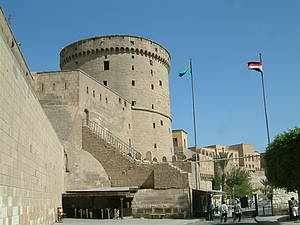
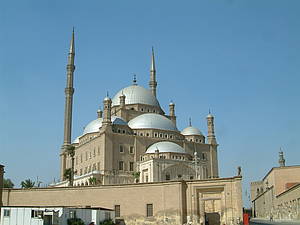
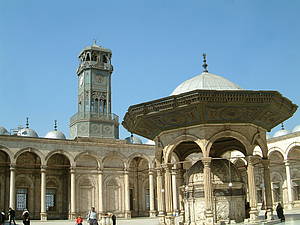
01 - Cairo
IBM and the Pharaoh´s Revenge
We have never been in Egypt before, but many of our friends were. Everyone told us that in Egypt there are two major risks: IBM risk and the risk of pharaoh´s revenge.
IBM does not mean in Egypt only an abbreviation for the computer manufacturer, it also stands for:
I - IN SHALAH which means if it is the will of God
B - BUKRA which means tomorrow
M -MAALESCH which means I do not care, it does not matter, I do not give a dam.
When IBM is consistently applied then nothing works, you never get anywhere on time and a half of your holiday is spent arguing about what was about to happen and did not happen.
The possible application of IBM by locals is a deeply disturbing element for many visitors to Egypt which in its extreme form can spoil their holiday. But I must say that we did not meet IBM at all. On the contrary, I can confirm that in all our career of frequent travelers we rarely had so well organized holiday. We found an Egyptian travel agency Gateway to Egypt (unsolicited advertising) on the Internet and tried to adjust our ever changing requirements on time and program to the real possibilities on spot by means of exchanging many emails until we got the individually tailored program agreed. When they asked for full payment in advance, we hesitated a little. We wrote them that we would pay ten percent in advance and the rest upon arrival (we were hoping that we would get all vouchers issued on arrival). They were offended and replied that if we did not trust them we did not need to pay any advance and the payment would be effectuated only on our arrival in Cairo. While this sounded nice, we realized that there were some hidden risks in proceeding this way. We could arrive in Cairo, and, theoretically, if no one would be waiting for us and nothing would be reserved, we could not do much about it because we did not even give them an advance. So we were a little nervous. But as I said, our skepticism was not justified. Everything worked like a clock. At the airport three members of office staff were already waiting. One of them took the passports and arranged visa on arrival in two minutes, the other one waited at the belt and took off our suitcases, the third one was waiting outside with a car. The organization continued like that during our entire stay. When we had to start at seven-thirty in the morning, the representatives of Gateway were always there already seven-fifteen, just to be sure. All the guides were professional archaeologists, enthusiastic professionals, and personally very pleasant people. Hotels and the ship were top notch. They took care of us like of their own, and most of the information that I have summarized here comes from them, because they were informed not only about the past, but also about the current events. So IBM did not hit us at all.
Otherwise with the Pharaoh´s Revenge, which is a euphemism for acute disorders of the digestive tract. You might think that something like this is caused by unsafe water drinking, by eating raw salads or vegetables in street restaurants, with contribution of unbearable desert heat combined with air conditioning, and that the Pharaoh does not have anything to do with that. But you are wrong: we have not committed any offence against the above rules (we are well knowledgeable about what to do and what not to do from India where we use bottled water even for cleaning the teeth - we behaved in the same way in Egypt), however, both of us were hit by Pharaoh´s revenge for couple of days. So there must be something to that legend.
Geography. A comparison: Egypt has 78 million people, only about 5 million less than the united Germany, but its area is three times larger than Germany. The inhabitants are Arabs, a small minority of Nubians (mainly in Assuan area and on the border with Sudan) and Berbers in the oasis of Siwa.
Religion: Sunni Muslims, about 6-10 percent are Christians, mostly Copts.
History
Besides the prehistoric era and era of Pharaohs (starting 3100 BC), the history of Egypt is one of various occupiers who invaded Egypt, starting with Alexander the Great in the year 332 BC, followed by Caliph Omar from Mecca (640 AD), the Fatimid Dynasty (Shia - 969), Kurdish leader Saladin (1171), Mameluks (1250), Turks (1517 – it became a part of the Ottoman Empire), Napoleon 1798-1801, Albanian Mohammed Ali (1805). During the construction of the Suez Canal Egypt fell into the sphere of influence of Great Britain (opened 1869), which granted the country formal independence only 1922 (declaration of a constitutional monarchy).
Women in Egypt
In the history of Egypt, there appear three important women:
1) Hatshepsut. After the death of her husband she prevented that minor nephew and stepson of Thutmosis II would gain the throne – she took it for herself (1467 BC). She built a mortuary temple in Luxor and many other monuments. She is shown in the old reliefs with a beard as a symbol of pharaoh´s power, but she is supposed to be a very pretty woman. After her death, the nephew took his revenge - he tried to remove all her portraits and clear her name from all hieroglyphic 'cartouche'. But to eradicate every mention of her which was carved into the stone proved to be an impossible task, because of extensive building activities during twenty years of her reign.
A sad story from the modern times: in 1997 about 50 foreign tourists died in front of Hatshepsut temple in Luxor during a terrorist attack.
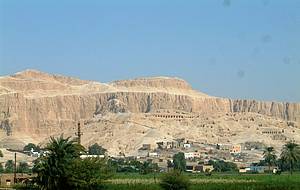
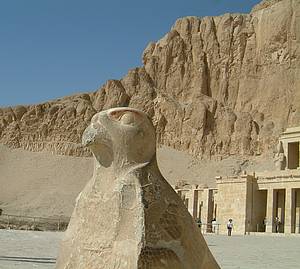
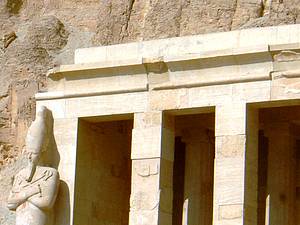
02 – Hatshepsut Temple
2) Nefertiti – wife of Pharaoh Echnaton (1379 BC). He was the one who commanded a belief in a single God of Sun Aten - before and after his era the Egyptians worshiped many gods, often called triads, such as the Triad of Abydos = Osiris, Isis and their son Horus, or Triad of Thebes = Amun, Mut and their son Chons, and others. Nefertiti has become known up to our time by a graceful bust with a slight smile and a missing eye which was presently moved from Charlottenburg Museum (former West Berlin) to the Old Museum on the Museum Island (former East Berlin). There is a dispute about the ownership of the bust between the German and Egyptian government although not very edgy one.
3) Cleopatra – the famous brilliant tactician at the end of Ptolemaic era (51 BC). There is no more need to comment, Shakespeare in his Anthony and Cleopatra said it all. The fact that she eventually preferred to let herself to be bitten by a cobra to giving in proves that she was a proud woman.
4) One more interesting discovery, relating to women and to the arts at the same time. In the year 1888 while working at excavations of necropolis near Fayyum oasis the archaeologist Flinders Petrie found a portrait of a girl painted on wood. It topped the face of mummy and thus served the same purpose as a posthumous gilded plaster masks or precious golden masks of pharaohs of ancient Egypt. Later on, Petrie found a number of such portraits. Their style is not idealized, and it is very individual. The archaeologists believe that they were painted during life of the girls who sat as a model for the portrait. It is not sure if they hanged the pictures at home before they died. However, the faces have a modern touch, the girls are stylish with high piled hair, wear jewelry, and look at us with big dark melancholic eyes, as if painted by Frida Kahlo. The style is so different from the art of the pharaohs that they got a special name the Portraits of Fayum.
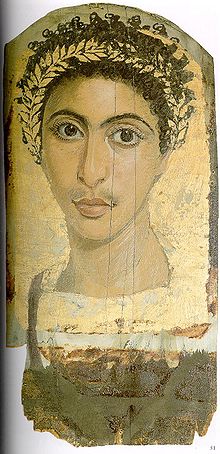
03 – A Portrait of a girl of Fayyum
Women today
Most of the women on the streets were wearing a shawl, but there were also plenty who did not cover their hair. The dispute over the shawl divides society also in Egypt. Ms. Nini of Aracan Power company (Nini and her husband invited us for a business dinner) came without a scarf and asked permission to light a cigarette. In Egypt, friends and acquaintances also make a double kiss on the cheek as a greeting, both women and men. Young high school girls whom we saw in front of the Muhammed Ali Mosque in Cairo had blue jeans, tops and multicolored scarves. They laughed, played and asked me if I would take a picture of them (which of course I did with pleasure). At home, women have a word in important matters, but otherwise the Egyptian society is dominated by men. When Thani al-Gibali became a judge of the Constitutional Court and its Vice-President as the first woman in 2003 she did not mince her words when making a cause for women. As for the shawl, her argument sounds as follows: covering hair is not only the Muslim custom, also Catholic nuns and orthodox Jewish women wear special head covers. But social conditions have changed so that this form of veiling should not be required any more. At the time of Mohammed women covered themselves to escape the harassment and not to provoke male desire. Thani said that nowadays this requirement could be interpreted as an insult to Muslim men, who are thus relegated to creatures subject to primitive instincts, if it is assumed that the mere sight of a woman's hair evokes their desire which they cannot dominate. At the same time the dispute about the right of women to divorce escalated in Egypt and Thani greatly contributed to promote at least partial changes (previously it was basically impossible for a woman to file a divorce). The new law is still far from perfect: a woman seeking a divorce is between a rock: when she applies for divorce with determination of guilt, she has to suffer years of uncertainties before the case is resolved (most judges are conservative men). If she applies for divorce without apportioning blame, she is not entitled to any financial compensation. So the struggle for emancipation continues, however, it has been presently pushed to the background by the struggle of different political and religious groups for power (note written 2013).
Not surprisingly, it is not the best idea for a woman to run around the town in shorts or lie down topless on the beaches of Egypt. But on the other hand, belly dancing comes from Egypt, so there are a lot of contradictions.
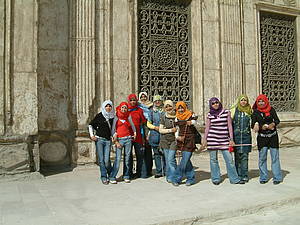
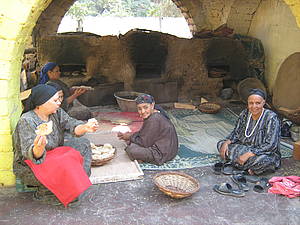
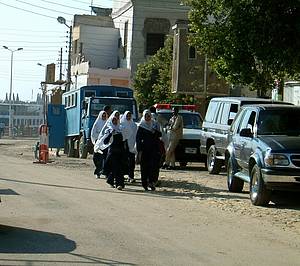
04 – Egyptian Women
Ancient and New Wonders of the World
Pyramids as a place of eternal rest of pharaohs 3,000 years before Christ - the only surviving ancient wonder of the world


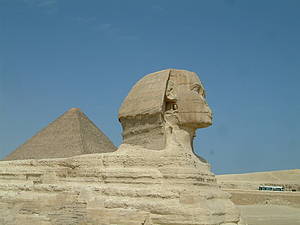
05 - Pyramids in Giza, the Sphinx
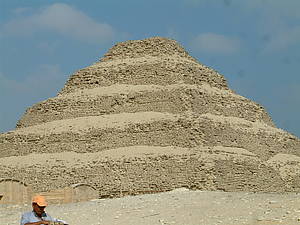
05a - Pyramid of Djoser in Saqqara
Tombs as a place of eternal rest of pharaohs 1,500 years before Christ - the pyramids were too visible and easily became prey to robbers, so Egyptians began to build tombs
Temples for the worship of the gods – fantastic buildings full of decorative columns, massive sculptures and reliefs, decorated with colorful frescoes, some amazingly preserved.
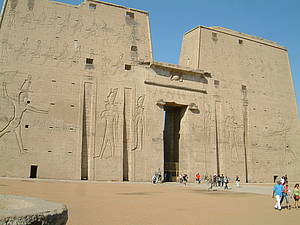
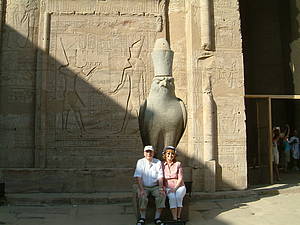
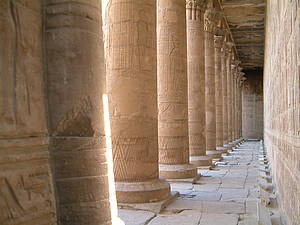
06 – Edfu Temple to Falcon God
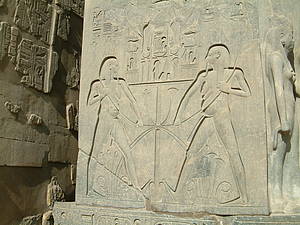
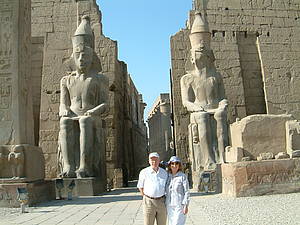
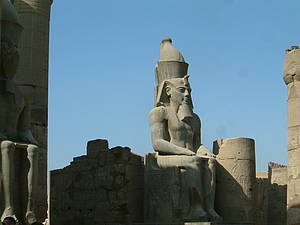
06a- Ramses Temple in Luxor
There is a nice story connected to the discovery of tombs. The Englishman Howard Carter, who came to Egypt in 1891 as an eighteen year old, made through his resilience and faith the impossible happen (of course also with the support of a millionaire, a passionate amateur Egyptologist Lord Carnarvon, because without money it would not have happened). He discovered in 1922-23 the tomb of Pharaoh Tutankhamen, the only tomb in the Valley of the Kings which was not burgled. When he had finally dug through several hallways and reached the funeral hall of Tutankhamen, Carter had stuck his head into the hole and Lord Carnarvon asked him eagerly: "What can you see?" Carter could not catch his breath for a moment and then he said: "Gold, gold, only gold” (the inner Tutankhamen sarcophagus is made of pure gold, weighs 225 kg, not speaking about all other golden objects in the tomb). After opening the sarcophagus Carter found Pharaoh´s mummy with the world famous death mask made of gold and precious stones. We could see most of these treasures in the Egyptian Museum in Cairo, which is otherwise a little bit disappointing because of the old fashioned haphazard arrangement of the exhibits which could be presented in a shining way. But two main halls, the hall with Tutankhamen treasures and the hall with the collection of mummies are so impressive that they quickly ease any criticism.

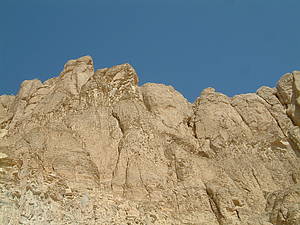
07 - Valley of Kings - Tutankhamen Tomb
Suez Canal (opened 1869) and Assuan Dam
There are two dams in Assuan, the upper and the lower dam. The lower was built by the British in the years 1899 - 1902 and later heightened two times. When it became obvious, that its capacity is insufficient, Egypt began to plan a new dam in the early fifties of the 20th century. Around the same time, in 1952, a group of young officers who called themselves “Free” overthrew the monarchy and declared a republic. In 1954, Egypt signed an agreement with Great Britain about the withdrawal of British troops. The charismatic Gamal Abdel Nasser became the head of the government. His policy was based on the independence from the Western powers, Egypt became a leading country in the Non-Aligned Movement, established diplomatic relations with China and began to place many orders for weapons, including tanks from Czechoslovakia (probably the largest military contract in the history of Czechoslovak arms industry). As they were upset by his independent policy, USA and Great Britain refused to give to Nasser already allocated funds for the construction of the upper dam in Assuan. Nasser responded by the nationalization of Suez Canal and by the introduction of fees for the passage of vessels which should provide finance for the construction of the dam. This move was followed by the Suez Crisis (1956), in which the world found itself on the brink of another World War, because the World Powers were standing in this conflict on the opposite sides. The crisis was fortunately averted with the help of the United Nations (it was of course much more complicated, but I'm not a military historian). The upper dam was then built on the funds given to Egypt by the Soviet Union, with the help of Soviet engineers and technicians. The dam is still one of the most important economic factors in Egypt, it enables navigability of the Nile and irrigation of dry regions for agriculture, prevents flooding and generates electricity. The impact on indigenous people, Nubians, who had to be moved, as well as the impact on the original flora and fauna, remains as usual in all cases of big hydro projects debatable.
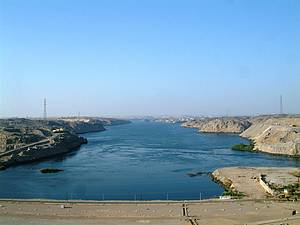
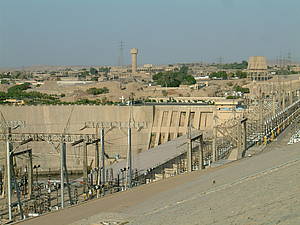
08 – Assuan Dam
Most of the archaeological treasures that would have been flooded were eventually rescued with the help of the international community. The river Nile around Assuan looks very romantic – the ancient vessels called feluccas are going around together with modern ships, passing the green banks of the Botanical Garden. From the local restaurants an impressive sun set can be watched whilst sipping your drink.
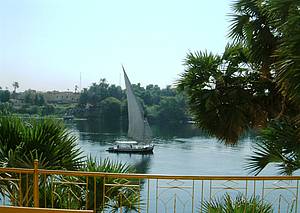
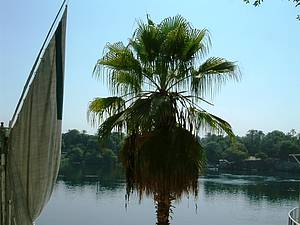
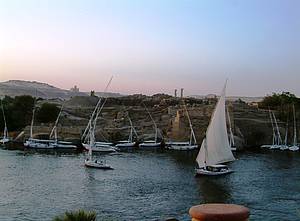
09 – Feluccas on the Nile - Assuan
Alexandria. Three years later (2010) we had in Egypt an established business and a capable distributor. During the second stay in Egypt we visited Alexandria, where we admired the waterfront of the Mediterranean Sea and a modern library, built on the site of the famous ancient one which did not survive. Once again, we could enjoy the hospitality of our business friends and tolerant atmosphere of the country.
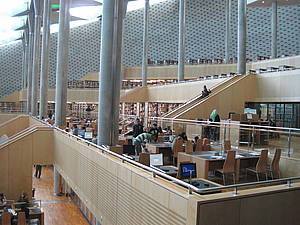
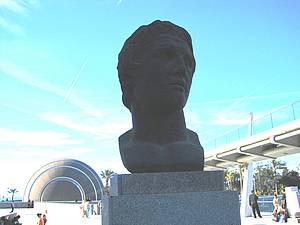
10 – Bibliotheka Alexandriana
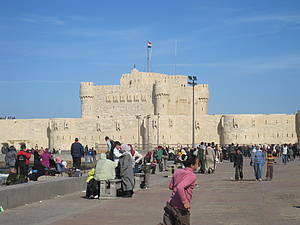
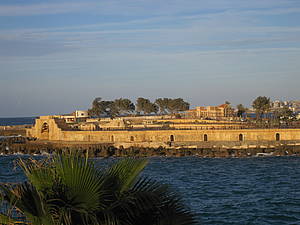

10a - Alexandria - Town
Note from October 2013. As can be seen from my "travel report from Egypt", we experienced the country as tolerant, welcoming and friendly. And suddenly, everything changed. Arab Spring in Egypt meant mass demonstrations against President Mubarak, which were brutally suppressed. Mubarak was overthrown and imprisoned, but the dream of a greater freedom soon turned into a nightmare. In democratic elections, the party the Muslim Brotherhood, banned under Mubarak, came to power and began to restrict democratic freedoms even more than it was in the past. There was an obvious threat that Egypt would become a Muslim state with Sharia as a prevailing law. With the support of freedom loving population, especially non Muslim minorities and moderate Muslims, the power was seized by the army which overthrew in a coup de etat the democratically elected President Mursí (who started to use methods of a dictator – “the taste of power is sweet, and difficult to resist”). The provisionally appointed President Adli Mansoor and the army are promising new democratic elections soon, however, in between the Muslim Brotherhood, which still has a support of a large part of the population, has been banned again. By that, a flourishing country, former tourist paradise, remains on the brink of the civil war.
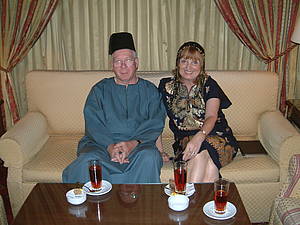
11 – Festivity in Egypt 2007
Schedule
Hotel Cairo: 3 nights- 3 Days
Nile Cruise: 7 Nights -8 Days
Hotel in Luxor: 1 Night-2 Days
Hotel Cairo: 1 night with late check out – 1 Day
Day 1/Sunday 14th October 2007
Arrive 6,50 a.m. by Egypt Air from Mumbai
Arrive Cairo International Airport, where you will be met by your Tour Representative who will assist you through Customs and Immigration, then transfer by private motor coach to your hotel.
Overnight Cairo
Day 2/Monday 15th October 2007
This morning the first visit will be to remains of ancient Memphis the first capital of ancient Egypt. Then drive to the area of Saqqara to visit the oldest step pyramid and some of the tombs in the area.
Lunch in a local restaurant
Afternoon tour in the Pyramids of Guiza to visit the only surviving monuments of the ancient wonders of the world. During the tour you will have the chance to climb inside one of the pyramids, visit the sphinx and enjoy a short camel ride.
Evening cultural activities can be suggested ( as folkloric shows, cultural activities , seminars and local restaurants
Day 3/Tuesday 16th October 2007
In the morning visit the Citadel Of Salah El Dein and the 19th century mosque of Mohamed Ali and the local market of Khan El Khalili.
Afterwards drive to the Egyptian Museum of Antiquities. The museum has a remarkable collection of antiquities including the treasures of the child pharaoh TutAnkhAmon .
Return to the hotel & overnight Cairo
Evening cultural activities can be suggested ( as folkloric shows, cultural activities , seminars and local restaurants
Day 4/Wednesday 17th October 2007
Flight to Luxor - Upon arrival drive to the the Temple of Luxor and the Temples of Karnak, Egypt’s greatest compound of temples. Drive to the Nile cruiser for check in.
Overnight Luxor ( Lunch& Dinner on board of the ship)
Day 5/Thursday 18th October 2007
Return to the boat and sail to Edfu.
Overnight Edfu( BRK, lunch& dinner on board)
Day 6/Friday 19th October 2007
This morning travellers will visit the best-preserved temple in Egypt: the Temple of Horus, the falcon god, built in 230 BC by Ptolemy III. Return to the cruiser and sail to Aswan.
Overnight Aswan ( BRK, lunch& dinner on board)
Day 7/Saturday 20th October 2007
Spend the morning visiting the High Dam, the quarries of the Unfinished Obelisk a practical demonstration of the methods used by ancient craftsmen. Then end the tour with visiting the exquisite Temple of Philae on the island of Agilkia.
Return to the boat.
In the afternoon the travellers will sail in a felucca past Elephantine Island and Lord Kitchener’s Botanical Gardens.
Return to the boat & overnight Aswan
(Brk,Lunch& Dinner on board)
Day 8/Sunday 21st October 2007
This morning take the OPTIONAL TRIP to the Temples of Abusimbel .
You can fly or drive to Abusimbel to explore the great rock-cut temples of Abu Simbel that were carved out of solid rock at a site on the west bank of the Nile south of Aswan in the land of Nubia. They are among the most magnificent monuments in the world. When the temples (280 km from Aswan) were threatened by submersion in Lake Nasser, due to the construction of the High Dam, the Egyptian Government secured the support of UNESCO and launched a world wide appeal and their removal and reconstruction was an historic event in itself.
Return to Aswan in the afternoon
Afternoon at leisure or make use of the chance to explore more of Aswan
Overnight Aswan (Brk,lunch&Dinner on board)
Day 9/Monday 22nd October 2007
Free Morning.
Afternoon sailing to Kom Ombo. Upon arrival visit the Greco Roman temple of Kom Ombo uniquely dedicated to two gods: Sobek, the crocodile god and Haroeris, the sun god.
Return to the cruiser & sail to Luxor
Overnight Esna (Brk, lunch & dinner on board)
Day 10/Tuesday 23rd October 2007
Early morning tour of the West Bank of Luxor. The tour will include visits to the tombs of the pharaohs in the Valley of the Kings and tombs of the princes & queens in the Valley of the Queens and the mortuary temple of Queen Hatshepsut finally view the Colossi of Memnon.
Return to the boat
Overnight Luxor (Brk, Lunch& Dinner on board)
Day 11/Wenesday 24th October 2007
Check out of the cruise drive to the hotel
Overnight Luxor
Day 11/Thursday 25th October 2007
Free day Luxor
Flight to Cairo MS 336 17,40 -18,45 – transfer to hotel in Cairo
Day 12/Friday 26th October 2007
Free day in Cairo
Day 13/Saturday 27th October 2007
Check out of hotel ( will request late check out )
Departure Cairo – Mumbai 2,30 a.m. by Egypt Air
5 stars Hotel 5 stars Nile cruise and private guides all the way
*Private transportation to & from airports and train stations
*Private Representative services in all airports and train stations
*4 nights accommodation in 5 stars hotel in Cairo on bed & breakfast basis - Mena House Oberoi
*7 nights accommodation in 5 stars Nile cruise on full board basis – MS Crown Prince
* 2 nights accommodation in 5 stars hotel in Luxor on bed & breakfast basis - Sonesta St. George
* All sightseeing in the attached program
* Services of a Private English speaking guide all over Cairo , including Nile cruise
* Domestic flights Cairo- Aswan /Luxor – Cairo
The Price DOES NOT include:-
* Optional trip to Abusimbel
*Visa to Egypt
*Airport taxes if applicable
*Excess baggage charges.
*All items of a personal nature such as laundry, medical expenses, room service, and beverages.
*Travel insurance
*Tipping to guides, representatives, drivers and Nile cruise staff


